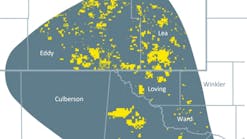With oil sands production climbing steadily and conventional production rebounding, Canadian oil production will more than double by 2030, predicts the Canadian Association of Petroleum Producers.
In its annual long-term forecast, CAPP projects total production in 2030 of 6.7 million b/d, compared with 3.2 million b/d in 2012.
Of the 2030 total, oil sands will represent 5.2 million b/d, conventional crude and condensate from western Canada 1.4 million b/d, and eastern Canada 100,000 b/d.
The 2012 breakout: oil sands 1.8 million b/d, western Canada 1.2 million b/d, and eastern Canada 200,000 b/d.
CAPP expects light crude from tight formations to account for most of the growth in conventional production in western Canada. In eastern Canada, CAPP says, the start-up of offshore Hebron oil field by the end of 2017 will help offset declines from older fields.
The forecast levels are up slightly from CAPP's outlook last year, which projected 5.02 million b/d from oil sands in 2030, 1.14 million b/d from western Canada conventional, and 90,000 b/d from eastern Canada (OGJ, July 2, 2012, p. 56).
Compared with last year's forecast, CAPP's projection for oil sands in 2030 has higher growth for in situ production and lower growth for mining.
CAPP now sees production rising to 3.5 million b/d from in situ methods and 1.7 million b/d from mining in 2030 from last year's 1 million b/d from in situ and 800,000 b/d from mining.
Markets, transportation
CAPP notes the need to reach new markets is "a top priority for Canadian oil producers."
Refineries in Quebec and the Atlantic provinces now import 86% of their feedstock and could absorb 700,000 b/d of Canadian oil, the group said. Refineries in Ontario have switched to domestic supplies, which now account for more than 90% of their feedstock.
Canadian oil can displace some of the 2.2 million b/d of imported heavy oil now processed in high-conversion refineries on the US Gulf Coast. CAPP forecasts Canadian oil reaching that market will rise to 1.1 million b/d by 2020 from 100,000 b/d at present.
Completion of conversion projects in Midwestern refineries will increase deliveries of Canadian oil, much of it heavy, to that region by 460,000 b/d by 2020. The Midwest currently receives 1.7 million b/d of Canadian oil.
High-conversion refineries in Washington and California also might become buyers of new volumes of Canadian oil as supplies of heavy feedstock from traditional sources decline.
China and India, to which Canadian oil now has limited access, also could become important markets. CAPP cites a US Energy Information Administration forecast that oil imports of the two countries combined will increase to 15.7 million b/d by 2030 from 9.2 million b/d by 2012.
CAPP says its outlook depends on growth in transportation capacity sufficient to accommodate the projected increase in supply. Although capacity is "currently tight," it says, no production has been shut in for lack of transportation.
"Protracted approval processes for new pipeline projects are resulting in a variety of creative transportation proposals to access markets," it says.


